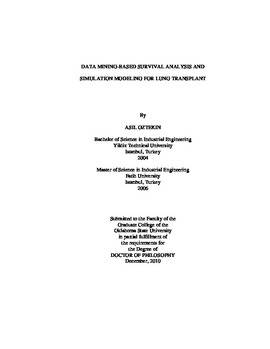| dc.contributor.advisor | Kong, Zhenyu James | |
| dc.contributor.author | Oztekin, Asil | |
| dc.date.accessioned | 2013-12-10T18:05:05Z | |
| dc.date.available | 2013-12-10T18:05:05Z | |
| dc.date.issued | 2010-12 | |
| dc.identifier.uri | https://hdl.handle.net/11244/7778 | |
| dc.description.abstract | Scope and Method of Study: The objective of this research is to develop a decision support methodology for the lung transplant procedure by investigating the UNOS nation-wide dataset via data mining-based survival analysis and simulation-based optimization. Traditional statistical techniques have various limitations which hinder the exploration of the information hidden under the voluminous data. The deployment of the structural equation modeling integrated with decision trees provides a more effective matching between the donor organ and the recipient. Such an integration preceded by powerful data mining models to determine which variables to include for survival analysis is validated via the simulation-based optimization. | |
| dc.description.abstract | Findings and Conclusions: The suggested data mining-based survival analysis was superior to the conventional statistical methods in predicting the lung graft survivability and in determining the critical variables to include in organ matching and allocation. The proposed matching index derived via structural equation model-based decision trees was validated to be a more effective priority-ranking mechanism than the current lung allocation scoring system. This validation was established by a simulation-based optimization model. It was demonstrated that with this novel matching index, a substantial improvement was achieved in the survival rate while only a short delay was caused in the average waiting time of candidate patients on the list. Furthermore, via the response surface methodology-based simulation optimization the optimal weighting scheme for the components of the novel matching index was determined by jointly optimizing the lung transplant performance measures, namely, the justice principle in terms of the waiting time and the utility principle in terms of the survival rate. The study presents uniqueness in that it provides a means to integrate the data mining modeling as well as simulation optimization with the survival analysis so that more useful information hidden in the large amount of data can be discovered. The developed methodology improves the modeling of matching and allocation system in terms of both interpretability and predictability. This will be beneficial to medical professionals at a great deal. | |
| dc.format | application/pdf | |
| dc.language | en_US | |
| dc.rights | Copyright is held by the author who has granted the Oklahoma State University Library the non-exclusive right to share this material in its institutional repository. Contact Digital Library Services at lib-dls@okstate.edu or 405-744-9161 for the permission policy on the use, reproduction or distribution of this material. | |
| dc.title | Data mining-based survival analysis and simulation modeling for lung transplant | |
| dc.contributor.committeeMember | Delen, Dursun | |
| dc.contributor.committeeMember | DeYong, Camille | |
| dc.contributor.committeeMember | Kolarik, William J. | |
| dc.contributor.committeeMember | Swim, Leva K. | |
| osu.filename | Oztekin_okstate_0664D_11255.pdf | |
| osu.accesstype | Open Access | |
| dc.type.genre | Dissertation | |
| dc.type.material | Text | |
| dc.subject.keywords | data mining | |
| dc.subject.keywords | healthcare | |
| dc.subject.keywords | lung transplant | |
| dc.subject.keywords | simulation optimization | |
| dc.subject.keywords | survival analysis | |
| thesis.degree.discipline | Industrial Engineering and Management | |
| thesis.degree.grantor | Oklahoma State University | |
